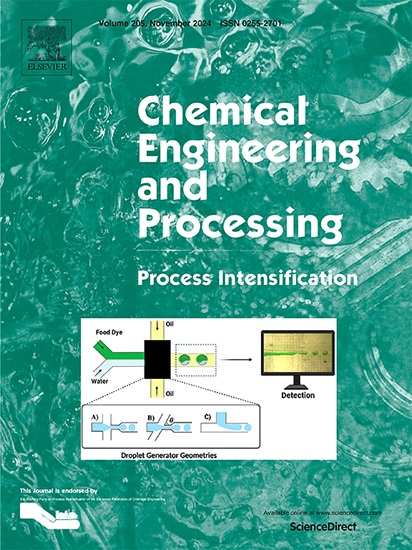Biocatalytic kinetics of the reaction between CO2 and tertiary amine using carbonic anhydrase
IF 3.8
3区 工程技术
Q3 ENERGY & FUELS
Chemical Engineering and Processing - Process Intensification
Pub Date : 2025-02-10
DOI:10.1016/j.cep.2025.110218
引用次数: 0
Abstract
Carbonic anhydrase (CA) is a high-efficiency biocatalyst that significantly improves the absorption of CO2 by tertiary amine. This work aims to investigate kinetics behaviors from the perspective of enzymatic reaction mechanism. The influences of the CA concentration, type of tertiary amines, pH, and temperature on the reaction rate between CO2 and tertiary amine (ν) and catalytic activity of CA (φ) were first investigated in a stopped-flow device. Adding 50 g∙m⁻³ CA enhanced ν in tertiary amine solutions by a factor ranging from 22 to 42 at 298 K and pH=9.5, demonstrating its excellent catalytic performance. The ν increased with increasing CA concentration, pH, temperature, and tertiary amine's pKa. φ increased with the increase of CA concentration, as well as the decrease of temperature, pH, and tertiary amine's pKa. Proteomics analysis further revealed that conformational changes of the CA's secondary structure induced by high pH and temperature altered the expressions of the local active-site region and deactivated CA, ultimately leading to a decrease in φ. Additionally, the CA-catalysis kinetics equation accorded with the Michaelis-Menten model, with catalytic second-order rate constants on the magnitude of 107. Overall, this work provides a guideline for its industrial application in the CO2 capture process.

二氧化碳与叔胺反应的碳酸酐酶生物催化动力学
碳酸酐酶(CA)是一种高效的生物催化剂,能显著提高叔胺对CO2的吸收。本工作旨在从酶促反应机理的角度研究其动力学行为。首先在停流装置上考察了CA浓度、叔胺种类、pH和温度对CO2与叔胺反应速率(ν)和CA (φ)催化活性的影响。在298 K和pH=9.5条件下,添加50 g∙m⁻³CA对叔胺溶液中的ν有22 ~ 42倍的增强作用,证明了其良好的催化性能。ν随CA浓度、pH、温度和叔胺pKa的增加而增大。φ随CA浓度的增加,温度、pH和叔胺pKa的降低而增大。蛋白质组学分析进一步发现,高pH和高温度引起CA二级结构构象变化,改变了局部活性位点区域的表达,使CA失活,最终导致φ降低。ca催化动力学方程符合Michaelis-Menten模型,催化二级速率常数约为107。本研究为其在CO2捕集过程中的工业应用提供了指导。
本文章由计算机程序翻译,如有差异,请以英文原文为准。
求助全文
约1分钟内获得全文
求助全文
来源期刊
CiteScore
7.80
自引率
9.30%
发文量
408
审稿时长
49 days
期刊介绍:
Chemical Engineering and Processing: Process Intensification is intended for practicing researchers in industry and academia, working in the field of Process Engineering and related to the subject of Process Intensification.Articles published in the Journal demonstrate how novel discoveries, developments and theories in the field of Process Engineering and in particular Process Intensification may be used for analysis and design of innovative equipment and processing methods with substantially improved sustainability, efficiency and environmental performance.

 求助内容:
求助内容: 应助结果提醒方式:
应助结果提醒方式:


